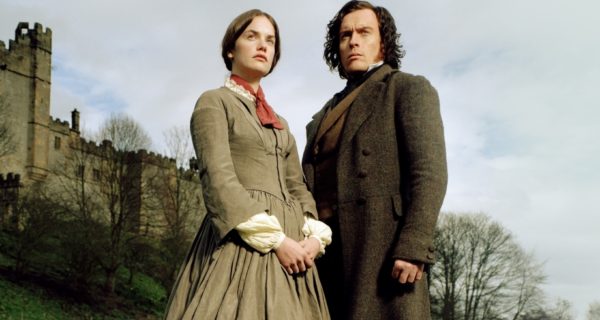If you’re searching for a tale of romance on Valentine’s Day, look no farther than the wonderful literary classic Jane Eyre by Charlotte Brontë. This is one of my favorite books of all time, one that I come back to each year. A lot of critical acclaim is given to Jane Austen’s work, such as Pride and Prejudice or Sense and Sensibility, but I personally find Charlotte Brontë’s writing to be more engaging and passionate. More modern, I suppose. Austen is clean, crisp, and sardonic; Bronte shakes with emotion. So if you haven’t picked up Jane Eyre, I highly recommend that you do so.
The title character Jane is one whom I find engaging, interesting, sympathetic, and relate-able. In a world of perfect gorgeous heroines, Jane is, as she says, “poor, obscure, plain, and little.” But she is full of heart, passion, and intelligence. Confined by the expectations and restraints of society, Jane seeks a place where she will be treated as an equal and granted the affection (be it romantic or platonic) that she craves. I think this is one of the earliest examples of a character claiming that love is a requirement for life, just as important as water and air.
And yet, despite this emphasis on love, Jane is also unwilling to compromise her morals and dignity for the sake of keeping love. Some critics have derided Jane as being too passive. It may appear that way on the surface, as Jane does seem to be the victim of circumstance through a good portion of the story. She makes very few grand actions, but the greatest and most moving of those decisions requires far more strength of will and character than such critics give her credit for.
Like many classics, Jane Eyre has spawned no less than ten film adaptations, with varying degrees of success. Some of them skimp on Jane’s early life to focus on the romance between her and Mr. Rochester, some drag on in the beginning or lose steam at the end, and many will get the physical characteristics of the characters wrong. It seems like if the film has an accurate Mr. Rochester, then St. John Rivers from the latter half of the story is inaccurate. The biggest complaint I usually have with the film adaptations is that the actors playing Jane and Mr. Rochester are often too good-looking for the role.
The first version I ever saw was the 1983 British TV mini-series starring Zelah Clarke as Jane and Timothy Dalton as Mr. Rochester. I recall enjoying the series for its accuracy; the entire span of the novel is covered in eleven episodes. Ms. Clarke and Andrew Bricknell, who plays St. John Rivers, certainly look the part and I love Mr. Dalton’s voice. However, the cinematography has a slightly stilted and static feel to it characteristic of many older low-budget British television, which keeps it from being my favorite.
The more recent 2011 movie version stars Mia Wasikowska (Alice from Tim Burton’s Alice in Wonderland) as Jane and Michael Fassbender as Mr. Rochester. This adaptation was interesting because it begins the film with Jane’s desperate flight from Thornfield Hall and then flashes back to begin building the story, rather than starting chronologically at the beginning like the book and most of the other films. It’s an interesting technique, but none of the main cast members look or feel like the characters. Ms. Wasikowska and Mr. Fassbender are simply too handsome to be convincing as the “plain” Jane and “ugly” Mr. Rochester.
Currently, my favorite film version of Jane Eyre is the 2006 TV mini-series with Ruth Wilson as Jane and Toby Stephens as Mr. Rochester. It has enough length to cover the novel’s plot without too much cutting or rearranging (a necessary evil with a movie), and, at least for me, captures the feel of the story the best. Granted, it does go through Jane’s childhood a little quickly and the latter part of the film with St. John Rivers is a little dull, but the bulk of the film focusing on Jane and Mr. Rochester is lovely. Both actors are probably the most faithful to their characters in appearance and manner, and I love watching them. I’ve probably watching this version five or six times, and plan to do so again.
I plan on watching the 1996 (with Charlotte Gainsbourg & William Hurt) and 1997 (with Samantha Morton & Ciaran Hinds) versions of Jane Eyre, which are the only other ones I have access to through my local library. The other five, made in 1910, 1934, 1943, 1970, and 1973, may prove harder to find, but I’m curious to see how they present this timeless tale of secrets and romance.
If you haven’t read Jane Eyre, I can’t recommend it highly enough. I think it may be better to read the book before watching any of the film adaptations because of the necessary editing involved in such a translation. For complete narrative accuracy, watch the 1983 Jane Eyre. For an experience that is probably more emotionally engaging to a modern audience, I recommend the 2006 Jane Eyre. Regardless, no matter how you choose to experience Charlotte Brontë’s masterpiece, you are in for a treat.

